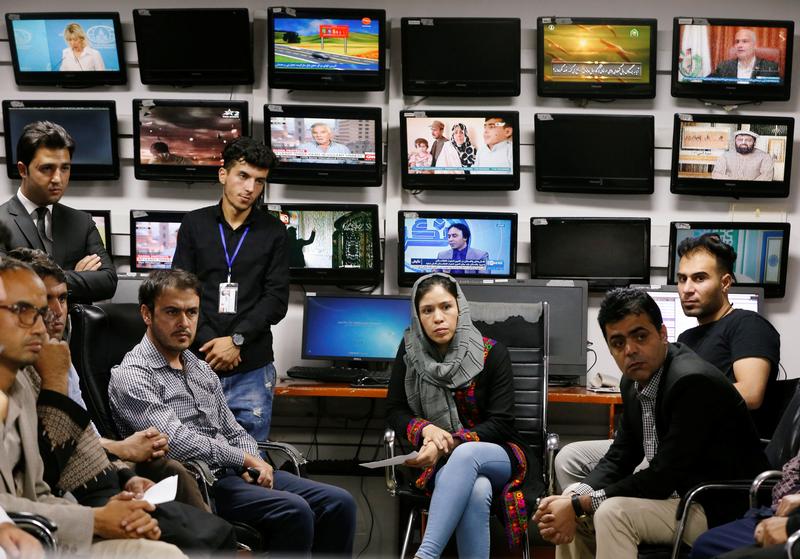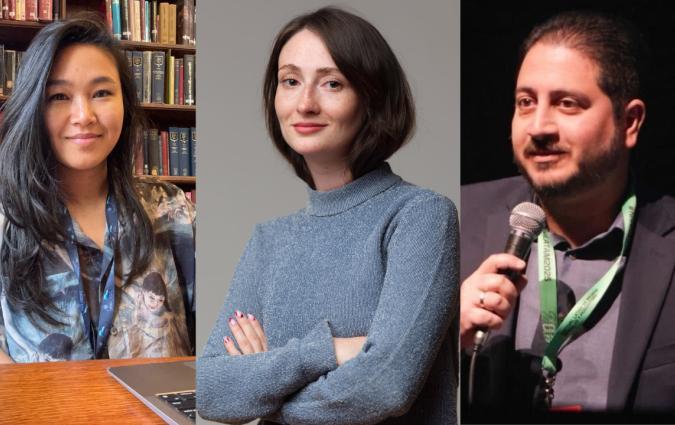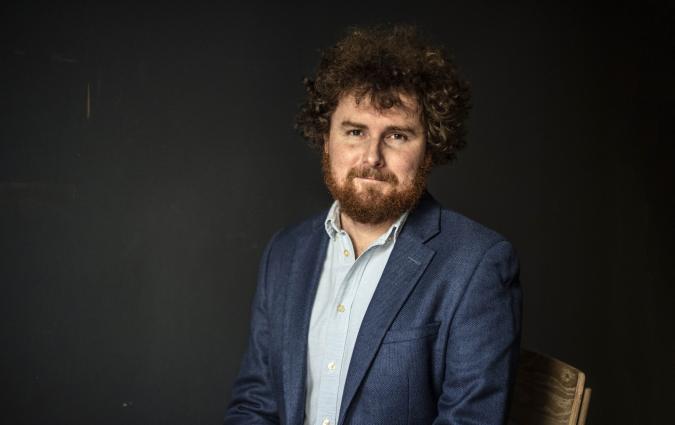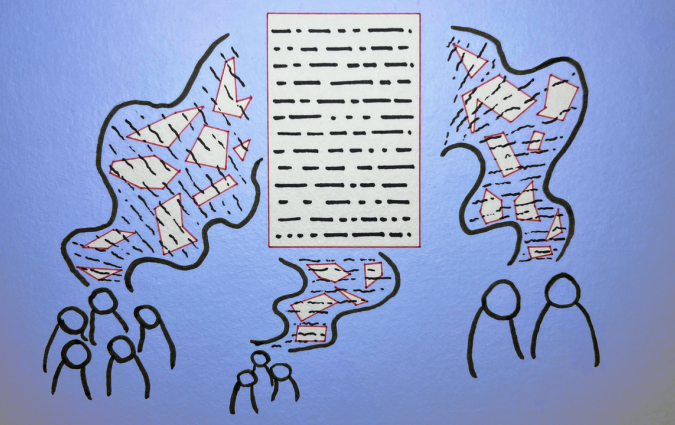Afghanistan's press freedom is threatened. Meet the young journalists fighting for it

Afghan journalists attend a meeting in the TOLO TV newsroom in Kabul. REUTERS/Omar Sobhani
Anisa Shahid covers elections, politics and human rights for TOLO TV, one of Afghanistan’s largest commercial TV channels. A graduate of Kabul University, she’s worked at the television station since the end of 2009. But now, women like her are under severe threat and they are not sure by whom. “We don’t know who is killing us”, she says.
Peace has been elusive for most Afghans for many decades. But the last few months have been especially difficult for journalists. According to official sources, 65 human rights defenders and media professionals were killed between January 2018 and January 2021.
As the country wrestles to form a new identity with fresh governance systems, violence has become more common. The Taliban, who ruled Afghanistan from 1996 to 2001, seek to return to power, while the West-supported government wants to keep control of the country. The Donald Trump administration struck a deal with the Taliban in February 2020 and committed to withdraw all US troops from the country by May 2021. On 13 April Joe Biden announced he will withdraw all the remaining US troops from Afghanistan by 11 September 2021.
As competing forces fight for supremacy, Afghanistan might see a complete shutdown of open civic spaces. “The Afghan people need and deserve a flourishing civic space, a society where people can think, write and voice their views openly without fear,” said recently Deborah Lyons, the UN Secretary-General’s Special Representative for Afghanistan.
Who is responsible?
Afghanistan is in the throes of a civil war, but no one can be conclusively blamed for it. Except maybe, ironically, the peace talks. Five human rights activists and six journalists have been killed in the months after the negotiations began in Doha last September. “The killings are a direct result of the peace talks,” Shahid says.
Some victims received threats in advance. Many others were not offered a warning before being killed.
Most attacks are carried out against journalists and activists. Heather Barr, former Afghanistan researcher at Human Rights Watch, said that the Taliban might be perpetrating them to shake people’s confidence or to go against people who they think perpetuate ‘western’ values.
The Afghan government has failed to maintain law and order. Nai Supporting Open Media, a media watchdog operating in Afghanistan, has called on the government “to end the impunity for crimes and violence against journalists… and bring their perpetrators to court.”
Thirty two-year-old Zaki Daryabi, publisher of Kabul-based Etilaatroz newspaper, said the government hasn’t responded to any such demands. According to Daryabi, both the government and the Taliban are afraid of independent journalism. The Taliban, Islamic State and other terrorist groups are responsible for a majority of the killings but not all.
The Committee to Protect Journalists has seen an uptick in journalists seeking help and protection, said Aliya Iftikhar, senior Asia researcher at the organisation. “There can be various perpetrators behind the attacks and many times no one claims responsibility. So, how do we prevent it?” she asks.
Shutting down media outlets is futile, says TOLO TV’s Shahid, since people have access to social media. However, the uncertainty has had a chilling effect on traditional media. “We think twice before we broadcast now,” said a journalist who requested anonymity for fear of being targeted. “It was not that way before.”
The rise of independent media
One of the biggest triumphs of the two decades since the US invasion of Afghanistan is the flourishing of a dynamic media space, Barr says.
Throughout the 1990s, Afghans fought to keep the Soviet Union at bay. By 1998, the Taliban were in control of almost 90% of Afghanistan. They banned TV, music and cinema. The only radio station was a Taliban-owned one spreading religious messages.
Along with the American soldiers, free elections, university education, civil society and independent media entered the country. Ali Yaar Adili, researcher at Afghanistan Analysts Network, an independent policy research organisation, calls the post-2001 era “a radical transformation of the country when every single aspect saw a change.”
Not every region of Afghanistan was altered. Urban areas remained under the control of the government whereas rural areas were still Taliban-controlled. Independent media came to be concentrated in cities and towns, but Afghans living in rural areas still got news produced in Kabul and other cities by listening to their radio sets.
Around 6.5 million Afghans are active on social media today, and more than 100 newspapers and 170 radio stations serve them. For a population starved of information, this sudden empowerment was revolutionary. Between 2001 and 2014, the media slowly earned the trust of the people, according to researcher Adili. “People began to look to the media not only for information, but to shape their socio-political views,” he says.
After the Taliban entered into negotiations with the US, violence went up. "It is definitely the Taliban [who are] behind this terror and these threats," a journalist who covered them and who fled the country after attempts on her life were made recently told CBS.
Journalists raising questions about the Afghan government are also under attack. Etilaatroz, the newspaper edited by Zaki Daryabi, has relentlessly exposed major corruption scandals about government officials since it was founded in 2012. In 2020, it was awarded the Anti-Corruption Award by Transparency International.
He has received threats. “One day all of my colleagues asked me to leave Afghanistan,” says Daryabi, who decided to hold out.
Most independent media in English and regional languages are mainly funded by foreign embassies and philanthropic grants. For instance, Etilaatroz works with Open Society, Internews and other grant making organisations. Very few media organisations survive on subscriptions and advertising revenue.
“From the time Barack Obama started pulling out US troops, lots of bureaus of foreign publications began pulling out as well,” said Kiran Nazish from The Coalition For Women In Journalism, a New York-based non-profit organisation which has helped endangered journalists flee Afghanistan.
According to Nazish, this produced a dangerous side-effect. The smaller the foreign media presence, the lower the press freedom for local media. Moreover, since the civil society in the US is not very interested in Afghanistan anymore, the few foreign correspondents who live in the country concentrate on security-related stories.
“The West has changed as well,” says HRW’s Barr. “Americans don’t think they can rescue hopeless Afghan women anymore.”
Apart from news media supported by philanthropy, there are a slew of radio stations and TV channels owned by religious and political leaders. While observers do not see this as going back to the pre-2001 age, they are not enthusiastic about the positive change these media outlets can have in the free exchange of ideas or exposing corruption.
What is important to note, according to Adili, is the age difference in media owners. “Most of the modern independent journalism platforms are owned and led by young people,” he says, indicating that the passion with which they approach their work makes a real difference.
Gender and education matters
More than 50% of Afghanistan's population is younger than 19 years old. Most of the young people who were born after the US invasion have never experienced the Taliban rule in the way the previous generation did, especially the 25% of Afghans who are city dwellers and have had access to university education.
Educating an entire generation ensures that they are equipped to ask the right questions and that they will demand an open civic space, says Adili. This group includes many women.
During the Taliban rule, girls above the age of 10 were not allowed to be educated. Now educated, working women have become targets at a time when the nation is defining its core identity. On March 2, three women who worked at Enikass Radio and TV were gunned down in the eastern city of Jalalabad. In December 2020, Enikass TV anchor Malala Maiwand was murdered in the same city too.

According to the International Federation of Journalists, over 300 Afghan female journalists have quit their jobs in recent months due to security concerns. Afghanistan is not an easy country for working women. Patriarchy is deeply entrenched and women in the media often work in tight-knit communities, either on the same shifts or in women-only newsrooms such as Zan TV, Afghanistan’s first all-female station employing about 50 people, all women in their 20s.
Women like TOLO TV’s Shahid have continued to work in the country despite the tough odds. In many other ways, she was not as much of an exception. Her family objected to her career choice, especially her father, who wanted her to become a teacher. “I went through a lot of problems until my family accepted my work,” she says.
“When they want to silence the press, they choose women journalists,” says Nazish, from The Coalition For Women In Journalism. Not only are they easy targets but also they send a strong message to the society. Many women journalists are often the breadwinners of their families. “Since their families are not particularly approving this”, she says, “there is a lot of mental torture.”
Holding the fort
On March 17, journalists in Afghanistan celebrated National Journalists' Day and they reiterated their commitment to press freedom. Some journalists believe that their lobbying has reduced violence. “We have seen a slight slump in violence in the latter half of March,” says Adili.
Almost everyone agrees that the most likely situation when the US withdraws completely is an escalation of the civil war. However, they also think the country has come too far to go back to how it was before 2001. “Afghanistan is a different country now. The Taliban also seem to have evolved in their own thinking. For example, they are allowing schools,” Nazish says.
Society has changed too. In March, after much backlash on social media, the Afghan government withdrew a ban on schoolgirls singing in public.
When the killings increased earlier this year, Daryabi joined a few other journalists to lobby for journalists' safety. Many were trying to leave Afghanistan. “We were wondering if we should leave too,” he says. “Would that be playing into the hands of those who want us out? We discussed a lot of issues with other journalists, foreign embassies and government officials.”
They decided to stay so they don’t lose the gains they’ve made in the last 20 years. “We should stand together,” he says.
Raksha Kumar is a freelance journalist, with a specific focus on human rights. Since 2011, she has reported from 12 countries across the world for outlets such as 'The New York Times', BBC, the 'Guardian', 'TIME', 'South China Morning Post' and 'The Hindu'. Samples of her work can be found here.







